Intense - Hack The Box

 Intense starts with code review of a flask application where we find an SQL injection vulnerability that we exploit with a time-based technique. After retrieving the admin hash, we’ll use a hash length extension attack to append the admin username and hash that we found in the database, while keeping the signature valid, then use a path traversal vulnerability to read the snmp configuration file. With the SNMP read-write community string we can execute commands with the daemon user. To escalate to root, we’ll create an SNMP configuration file with the agentUser set to root, then wait for the SNMP daemon to restart to so we can execute commands as root.
Intense starts with code review of a flask application where we find an SQL injection vulnerability that we exploit with a time-based technique. After retrieving the admin hash, we’ll use a hash length extension attack to append the admin username and hash that we found in the database, while keeping the signature valid, then use a path traversal vulnerability to read the snmp configuration file. With the SNMP read-write community string we can execute commands with the daemon user. To escalate to root, we’ll create an SNMP configuration file with the agentUser set to root, then wait for the SNMP daemon to restart to so we can execute commands as root.

 On Cache, we start off with bypassing a simple login form that uses client-side user/password validation, then find a vhost with a vulnerable OpenEMR application. After bypassing the login page, obtaining a valid session cookie and dumping the database through a SQLi injection vulnerability we exploit yet another OpenEMR CVE to get a shell. From there we have access to a memcache instance holding more credentials in memory so we can escalate to another user. Using the docker group membership of that last user, we’re able to launch a privileged container and get root privileges on the host itself.
On Cache, we start off with bypassing a simple login form that uses client-side user/password validation, then find a vhost with a vulnerable OpenEMR application. After bypassing the login page, obtaining a valid session cookie and dumping the database through a SQLi injection vulnerability we exploit yet another OpenEMR CVE to get a shell. From there we have access to a memcache instance holding more credentials in memory so we can escalate to another user. Using the docker group membership of that last user, we’re able to launch a privileged container and get root privileges on the host itself.
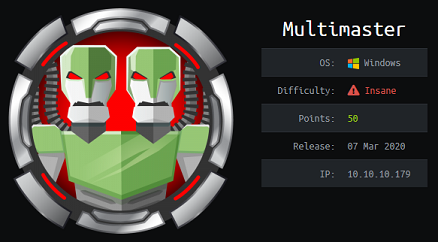 Multimaster was a challenging Windows machine that starts with an SQL injection so we can get a list of hashes. The box author threw a little curve ball here and it took me a while to figure that the hash type was Keccak-384, and not SHA-384. After successfully spraying the cracked password, we exploit a local command execution vulnerability in VS Code, then find a password in a DLL file, perform a targeted Kerberoasting attack and finally use our Server Operators group membership to get the flag.
Multimaster was a challenging Windows machine that starts with an SQL injection so we can get a list of hashes. The box author threw a little curve ball here and it took me a while to figure that the hash type was Keccak-384, and not SHA-384. After successfully spraying the cracked password, we exploit a local command execution vulnerability in VS Code, then find a password in a DLL file, perform a targeted Kerberoasting attack and finally use our Server Operators group membership to get the flag.
 Magic starts with a classic PHP insecure upload vulnerability that let us place a webshell on the target host and then we exploit a subtle webserver misconfiguration to execute the webshell (even though the file name doesn’t end with a .php extension). Once we land a shell, we escalate to another user with credentials found in MySQL and priv esc to root by exploiting a path hijack vulnerability in a SUID binary.
Magic starts with a classic PHP insecure upload vulnerability that let us place a webshell on the target host and then we exploit a subtle webserver misconfiguration to execute the webshell (even though the file name doesn’t end with a .php extension). Once we land a shell, we escalate to another user with credentials found in MySQL and priv esc to root by exploiting a path hijack vulnerability in a SUID binary.
 Control runs a vulnerable PHP web application that controls access to the admin page by checking the X-Forwarded-For HTTP header. By adding the X-Forwarded-For HTTP header with the right IP address we can access the admin page and exploit an SQL injection to write a webshell and get RCE. After pivoting to another user with the credentials found in the MySQL database, we get SYSTEM access by modifying an existing service configuration from the registry.
Control runs a vulnerable PHP web application that controls access to the admin page by checking the X-Forwarded-For HTTP header. By adding the X-Forwarded-For HTTP header with the right IP address we can access the admin page and exploit an SQL injection to write a webshell and get RCE. After pivoting to another user with the credentials found in the MySQL database, we get SYSTEM access by modifying an existing service configuration from the registry.
 Bankrobber is a web app box with a simple XSS and SQL injection that we have to exploit in order to get the source code of the application and discover a command injection vulnerability in the backdoor checker page that’s only reachable from localhost. By using the XSS to make a local request to that page, we can get land a shell on the box. To get root, we exploit a buffer in an application to override the name of the binary launched by the program.
Bankrobber is a web app box with a simple XSS and SQL injection that we have to exploit in order to get the source code of the application and discover a command injection vulnerability in the backdoor checker page that’s only reachable from localhost. By using the XSS to make a local request to that page, we can get land a shell on the box. To get root, we exploit a buffer in an application to override the name of the binary launched by the program.
 Zetta is another amazing box by jkr. The first part was kinda tricky because you had to pay attention to the details on the webpage and spot the references to IPv6 that lead you to the EPTR command to disclose the IPv6 address of the server. Then there’s some light bruteforcing of rsync’s credentials with a custom bruteforce script and finally a really cool SQL injection in a syslog PostgreSQL module.
Zetta is another amazing box by jkr. The first part was kinda tricky because you had to pay attention to the details on the webpage and spot the references to IPv6 that lead you to the EPTR command to disclose the IPv6 address of the server. Then there’s some light bruteforcing of rsync’s credentials with a custom bruteforce script and finally a really cool SQL injection in a syslog PostgreSQL module.
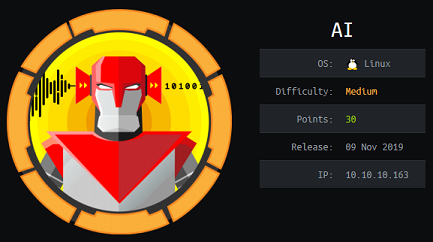 Exploiting the simple SQL injection vulnerability on the AI box was harder than expected because of the text-to-speech conversion required. I had to use a few tricks to inject the single quote in the query and the other parameters needed for the injection.
Exploiting the simple SQL injection vulnerability on the AI box was harder than expected because of the text-to-speech conversion required. I had to use a few tricks to inject the single quote in the query and the other parameters needed for the injection.
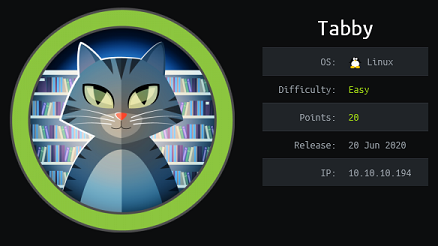 Tabby was an easy box with simple PHP arbitrary file ready, some password cracking, password re-use and abusing LXD group permissions to instantiate a new container as privileged and get root access. I had some trouble finding the tomcat-users.xml file so installed Tomcat locally on my VM and found the proper path for the file.
Tabby was an easy box with simple PHP arbitrary file ready, some password cracking, password re-use and abusing LXD group permissions to instantiate a new container as privileged and get root access. I had some trouble finding the tomcat-users.xml file so installed Tomcat locally on my VM and found the proper path for the file.
 Travel is an awesome box from my ATeam teammates xct and jkr. The box has a code review part where we analyze the source code of a PHP web app to find a command injection vulnerability in a curl command. We then use the Gopher protocol to perform SSRF and write a serialized PHP payload into the memcache database. For the priv esc part, we manipulate attributes of a user in an LDAP database which is used by the NSS facility to extend the Linux authentication database.
Travel is an awesome box from my ATeam teammates xct and jkr. The box has a code review part where we analyze the source code of a PHP web app to find a command injection vulnerability in a curl command. We then use the Gopher protocol to perform SSRF and write a serialized PHP payload into the memcache database. For the priv esc part, we manipulate attributes of a user in an LDAP database which is used by the NSS facility to extend the Linux authentication database.
 Quick was a hard box with multiple steps requiring the use of the QUIC protocol to access one section of the website and get the customer onboarding PDF with a set of default credentials. We get to play with ESI template injection to get the initial shell, then abuse a race condition in a PHP script so we can pivot to another user then finally we priv esc to root by finding credentials in the printer configuration file.
Quick was a hard box with multiple steps requiring the use of the QUIC protocol to access one section of the website and get the customer onboarding PDF with a set of default credentials. We get to play with ESI template injection to get the initial shell, then abuse a race condition in a PHP script so we can pivot to another user then finally we priv esc to root by finding credentials in the printer configuration file.
 Traceback was an easy box where you had to look for an existing webshell on the box, then use it to get the initial foothold. Then there was some typical sudo stuff with a LUA interpreter giving us access as another user then for privesc we find that we can write to /etc/update-motd.d and those scripts get executed by root.
Traceback was an easy box where you had to look for an existing webshell on the box, then use it to get the initial foothold. Then there was some typical sudo stuff with a LUA interpreter giving us access as another user then for privesc we find that we can write to /etc/update-motd.d and those scripts get executed by root.
 Forwardslash starts off like most classic Hack The Box machines with some enumeration of vhosts, files and directories with gobuster then we use a Server-Side Request Forgery (SSRF) vulnerability to reach a protected dev directory only accessible from localhost. After finding credentials and getting a shell, we’ll analyze and exploit a small backup program to read files as user pain and find more credentials. In the spirit of Team Unintended, instead of solving the crypto challenge to get root I used the sudo commands available to me to upload and mount my own Luks container and execute a SUID bash binary.
Forwardslash starts off like most classic Hack The Box machines with some enumeration of vhosts, files and directories with gobuster then we use a Server-Side Request Forgery (SSRF) vulnerability to reach a protected dev directory only accessible from localhost. After finding credentials and getting a shell, we’ll analyze and exploit a small backup program to read files as user pain and find more credentials. In the spirit of Team Unintended, instead of solving the crypto challenge to get root I used the sudo commands available to me to upload and mount my own Luks container and execute a SUID bash binary.
 Sniper is another box I got access to through an unintended method. The PHP application wasn’t supposed to be exploitable through Remote File Inclusion but because it runs on Windows, we can use UNC path to include a file from an SMB share. Once I had a shell, I pivoted using plink and logged in as user Chris with WinRM. The box author was nice enough to leave hints as to what kind of malicious payload was expected and I used Nishang to generate a CHM payload and get Administrator access.
Sniper is another box I got access to through an unintended method. The PHP application wasn’t supposed to be exploitable through Remote File Inclusion but because it runs on Windows, we can use UNC path to include a file from an SMB share. Once I had a shell, I pivoted using plink and logged in as user Chris with WinRM. The box author was nice enough to leave hints as to what kind of malicious payload was expected and I used Nishang to generate a CHM payload and get Administrator access.
 OpenAdmin is an easy box that starts with using an exploit for the OpenNetAdmin software to get initial RCE. Then we get credentials from the database config and can re-use them to connect by SSH. We then find another web application with an hardcoded SHA512 hash in the PHP code for the login page. After cracking it we’re able to log in and obtain an encrypted SSH key that we have to crack. After getting one more shell, we can run nano as root with sudo and spawn a shell as root.
OpenAdmin is an easy box that starts with using an exploit for the OpenNetAdmin software to get initial RCE. Then we get credentials from the database config and can re-use them to connect by SSH. We then find another web application with an hardcoded SHA512 hash in the PHP code for the login page. After cracking it we’re able to log in and obtain an encrypted SSH key that we have to crack. After getting one more shell, we can run nano as root with sudo and spawn a shell as root.
 This writeup is outdated and the attack path presented for user bolt has been patched. Initially once we pivoted from the bolt user to www-data we could run restic as root and abuse the sftp.command parameter to execute any command as root.
This writeup is outdated and the attack path presented for user bolt has been patched. Initially once we pivoted from the bolt user to www-data we could run restic as root and abuse the sftp.command parameter to execute any command as root.
 To get remote code execution on JSON, I exploited a deserialization vulnerability in the web application using the Json.net formatter. After getting a shell I could either get a quick SYSTEM shell by abusing SeImpersonatePrivileges with Juicy Potato or reverse the Sync2FTP application to decrypt its configuration and find the superadmin user credentials.
To get remote code execution on JSON, I exploited a deserialization vulnerability in the web application using the Json.net formatter. After getting a shell I could either get a quick SYSTEM shell by abusing SeImpersonatePrivileges with Juicy Potato or reverse the Sync2FTP application to decrypt its configuration and find the superadmin user credentials.
 I had fun solving RE but I did it using an unintended path. After getting a shell with a macroed .ods file, I saw that the Winrar version had a CVE which allowed me to drop a webshell in the webserver path and get RCE as iis apppool\re. The user had access to modify the UsoSvc service running with SYSTEM privileges so it was trivial at that point to get a SYSTEM shell. Because the root flag was encrypted for user Coby, I used meterpreter to impersonate his token and read the file.
I had fun solving RE but I did it using an unintended path. After getting a shell with a macroed .ods file, I saw that the Winrar version had a CVE which allowed me to drop a webshell in the webserver path and get RCE as iis apppool\re. The user had access to modify the UsoSvc service running with SYSTEM privileges so it was trivial at that point to get a SYSTEM shell. Because the root flag was encrypted for user Coby, I used meterpreter to impersonate his token and read the file.
 I solved this gitlab box the unintended way by exploiting the git pull command running as root and using git post-merge hooks to execute code as root. I was able to get a root shell using this method but I still had to get an initial shell by finding the gitlab credentials in some obfuscated javascript and modifying PHP code in the repo to get RCE.
I solved this gitlab box the unintended way by exploiting the git pull command running as root and using git post-merge hooks to execute code as root. I was able to get a root shell using this method but I still had to get an initial shell by finding the gitlab credentials in some obfuscated javascript and modifying PHP code in the repo to get RCE.
 Blackfield was a fun Windows box where we get a list of potential usernames from an open SMB share, validate that list using kerbrute, then find and crack the hash of an account with the AS-REProasting technique. After getting that first user, we’ll use Bloodhound to discover that we can change another account’s password, then from there access a previously locked down SMB share, retrieve an LSASS dump file and get more credentials. For the last part of the box we’ll abuse the Backup Operators role to download a copy of the NTDS.dit file and recover the administrator NT hash.
Blackfield was a fun Windows box where we get a list of potential usernames from an open SMB share, validate that list using kerbrute, then find and crack the hash of an account with the AS-REProasting technique. After getting that first user, we’ll use Bloodhound to discover that we can change another account’s password, then from there access a previously locked down SMB share, retrieve an LSASS dump file and get more credentials. For the last part of the box we’ll abuse the Backup Operators role to download a copy of the NTDS.dit file and recover the administrator NT hash.
 Sauna is a good beginner-friendly AD box that covers a few key Windows exploitation topics like AS-REP roasting, enumeration for credentials, using tools such as Powerview to find attack paths, DCsync and Pass-The-Hash techniques.
Sauna is a good beginner-friendly AD box that covers a few key Windows exploitation topics like AS-REP roasting, enumeration for credentials, using tools such as Powerview to find attack paths, DCsync and Pass-The-Hash techniques.
 Monteverde was an Active Directory box on the easier side that requires enumerating user accounts then password spraying to get an initial shell. Then we find more credentials looking around the box and eventually find the MSOL account password which we use to get administrator access.
Monteverde was an Active Directory box on the easier side that requires enumerating user accounts then password spraying to get an initial shell. Then we find more credentials looking around the box and eventually find the MSOL account password which we use to get administrator access.
 Forest is a nice easy box that go over two Active Directory misconfigurations / vulnerabilities: Kerberos Pre-Authentication (disabled) and ACLs misconfiguration. After I retrieve and cracked the hash for the service account I used aclpwn to automate the attack path and give myself DCsync rights to the domain.
Forest is a nice easy box that go over two Active Directory misconfigurations / vulnerabilities: Kerberos Pre-Authentication (disabled) and ACLs misconfiguration. After I retrieve and cracked the hash for the service account I used aclpwn to automate the attack path and give myself DCsync rights to the domain.
 Admirer is an easy box with the typical ‘gobuster/find creds on the webserver’ part, but after we use a Rogue MySQL server to read files from the server file system, then for privesc there’s a cool sudo trick with environment variables so we can hijack the python library path and get RCE as root.
Admirer is an easy box with the typical ‘gobuster/find creds on the webserver’ part, but after we use a Rogue MySQL server to read files from the server file system, then for privesc there’s a cool sudo trick with environment variables so we can hijack the python library path and get RCE as root.
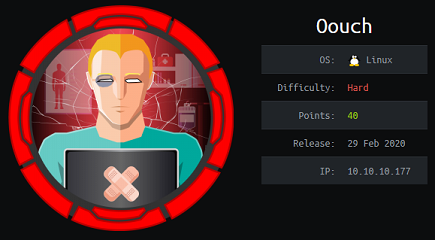 Ooauth was a pretty tough box because I was unfamiliar with Oauth and it took a while to figure out the bits and pieces to chain together. The priv esc was pretty cool, we had to talk to the uwsgi socket directly to manipulate the REMOTE_ADDR variable and exploit a command injection vulnerability in the script calling iptables.
Ooauth was a pretty tough box because I was unfamiliar with Oauth and it took a while to figure out the bits and pieces to chain together. The priv esc was pretty cool, we had to talk to the uwsgi socket directly to manipulate the REMOTE_ADDR variable and exploit a command injection vulnerability in the script calling iptables.
 Craft was a fun Silicon Valley themed box where we have to exploit a vulnerable REST API eval function call to get RCE. After getting a shell on the app container, we escalate to a user shell on the host OS by finding credentials and SSH private keys. To gain root access, we have to generate an OTP token with the vault software installed on the machine.
Craft was a fun Silicon Valley themed box where we have to exploit a vulnerable REST API eval function call to get RCE. After getting a shell on the app container, we escalate to a user shell on the host OS by finding credentials and SSH private keys. To gain root access, we have to generate an OTP token with the vault software installed on the machine.
 Professional Offensive Operations (P.O.O.) was the first endgame lab released by Hack The Box. It contained five different flags spread across two Windows machines. The initial part required some tricky recon with ds_store and IIS short names to find a MSSQL DB connection string. We then had to pivot by abusing the trust between MSSQL linked servers. The lab also had kerberoasting, password cracking, mimikatz and attack path enumeration with Bloodhound in it.
Professional Offensive Operations (P.O.O.) was the first endgame lab released by Hack The Box. It contained five different flags spread across two Windows machines. The initial part required some tricky recon with ds_store and IIS short names to find a MSSQL DB connection string. We then had to pivot by abusing the trust between MSSQL linked servers. The lab also had kerberoasting, password cracking, mimikatz and attack path enumeration with Bloodhound in it.
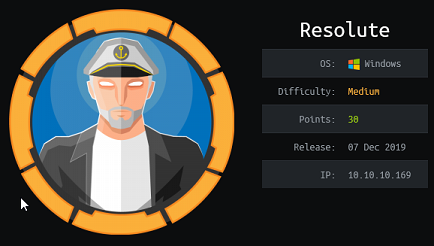 We start Resolute with enumeration of the domain user accounts using an anonymous bind session to the LDAP server and find an initial password in the description field of one of the account. Password spraying the password against all the discovered accounts give us an initial shell then we pivot to another user after finding creds in a console history file. The priv esc is pretty cool: we’re in the DNS admins group so we can reconfigure the DNS service to run an arbitrary DLL as SYSTEM.
We start Resolute with enumeration of the domain user accounts using an anonymous bind session to the LDAP server and find an initial password in the description field of one of the account. Password spraying the password against all the discovered accounts give us an initial shell then we pivot to another user after finding creds in a console history file. The priv esc is pretty cool: we’re in the DNS admins group so we can reconfigure the DNS service to run an arbitrary DLL as SYSTEM.
 To solve Fuse, we’ll do some enumeration to gather potential usernames from the print jobs information then build a password list from the strings on the website. After successfully password spraying, we’ll reset the expired password to a new one then use rpcclient to identify a printer service account and find its password in a description field. To priv esc, we’ll use the ability of our user with Printer Operators right to load a malicous kernel driver and get SYSTEM.
To solve Fuse, we’ll do some enumeration to gather potential usernames from the print jobs information then build a password list from the strings on the website. After successfully password spraying, we’ll reset the expired password to a new one then use rpcclient to identify a printer service account and find its password in a description field. To priv esc, we’ll use the ability of our user with Printer Operators right to load a malicous kernel driver and get SYSTEM.
 I initially thought for Book that the goal was to get the administrator’s session cookie via an XSS but instead we have to create a duplicate admin account by using a long email address that gets truncated to the existing one. Once we have access to the admin page we then exploit an XSS vulnerability in the PDF generator to read SSH keys for the low priv user. We priv esc using a race condition vulnerability in logrotate so we can backdoor /etc/bash_completion.d.
I initially thought for Book that the goal was to get the administrator’s session cookie via an XSS but instead we have to create a duplicate admin account by using a long email address that gets truncated to the existing one. Once we have access to the admin page we then exploit an XSS vulnerability in the PDF generator to read SSH keys for the low priv user. We priv esc using a race condition vulnerability in logrotate so we can backdoor /etc/bash_completion.d.
 To solve Unbalanced, we’ll find configuration backups files in EncFS and after cracking the password and figuring out how EncFS works, we get the Squid proxy cache manager password that let us discover internal hosts. Proxying through Squid, we then land on a login page that uses Xpath to query an XML backend database. We perform Xpath injection to retrieve the password of each user, then port forward through the SSH shell to reach a Pi-Hole instance, vulnerable to a command injection vulnerability.
To solve Unbalanced, we’ll find configuration backups files in EncFS and after cracking the password and figuring out how EncFS works, we get the Squid proxy cache manager password that let us discover internal hosts. Proxying through Squid, we then land on a login page that uses Xpath to query an XML backend database. We perform Xpath injection to retrieve the password of each user, then port forward through the SSH shell to reach a Pi-Hole instance, vulnerable to a command injection vulnerability.
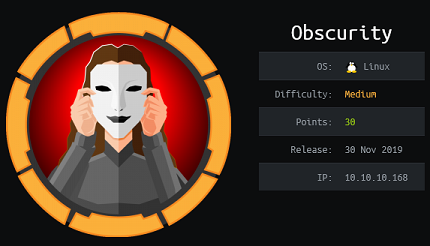 The Obscurity box has a vulnerable Python web application running. After finding the source code from a secret directory we find that the exec call can be command injected to get a shell as www-data. Then we have to solve a simple crypto challenge to retrieve an encryption key that decrypts a file containing the robert user’s password. We finally get root by exploiting a race condition in a python script so that we can copy the /etc/shadow file and crack the root password.
The Obscurity box has a vulnerable Python web application running. After finding the source code from a secret directory we find that the exec call can be command injected to get a shell as www-data. Then we have to solve a simple crypto challenge to retrieve an encryption key that decrypts a file containing the robert user’s password. We finally get root by exploiting a race condition in a python script so that we can copy the /etc/shadow file and crack the root password.
 Dyplesher was a pretty tough box that took me more than 10 hours to get to the user flag. There’s quite a bit of enumeration required to get to the git repo and then find memcached credentials from the source code. I couldn’t use the memcache module from Metasploit here since it doesn’t support credentials so I wrote my own memcache enumeration script. We then make our way to more creds in Gogs, then craft a malicious Minecraft plugin to get RCE. To get to the first flag we’ll sniff AMQP creds from the loopback interface. To priv esc, we send messages on the RabbitMQ bug and get the server to download and execute a lua script (Cubberite plugin).
Dyplesher was a pretty tough box that took me more than 10 hours to get to the user flag. There’s quite a bit of enumeration required to get to the git repo and then find memcached credentials from the source code. I couldn’t use the memcache module from Metasploit here since it doesn’t support credentials so I wrote my own memcache enumeration script. We then make our way to more creds in Gogs, then craft a malicious Minecraft plugin to get RCE. To get to the first flag we’ll sniff AMQP creds from the loopback interface. To priv esc, we send messages on the RabbitMQ bug and get the server to download and execute a lua script (Cubberite plugin).
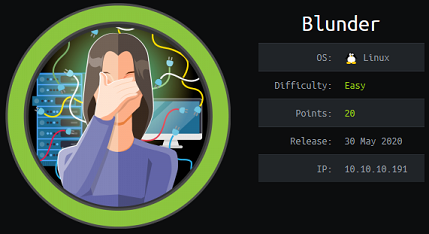 Blunder was an easy box for beginners that required bruteforcing the login for a Bludit CMS, then exploiting a known CVE through Metasploit to get remote code execution. The priv esc is a neat little CVE with sudo that allows us to execute commands as root even though the root username is supposed to be blocked.
Blunder was an easy box for beginners that required bruteforcing the login for a Bludit CMS, then exploiting a known CVE through Metasploit to get remote code execution. The priv esc is a neat little CVE with sudo that allows us to execute commands as root even though the root username is supposed to be blocked.
 Fawn corresponde a la segunda caja de la serie Learn the Basics of Penetration Testing, para la resolución de este objetivo es necesario generar una instancia de máquina a través de openVPN. Fawn explota las vulnerabilidades del Protocolo de Transferencia de Archivos (FTP). Asi que, sigamos y hackeemos la segunda caja de Hack The Box.
Fawn corresponde a la segunda caja de la serie Learn the Basics of Penetration Testing, para la resolución de este objetivo es necesario generar una instancia de máquina a través de openVPN. Fawn explota las vulnerabilidades del Protocolo de Transferencia de Archivos (FTP). Asi que, sigamos y hackeemos la segunda caja de Hack The Box.
 Dancing corresponde a la tercera caja de la serie Learn the Basics of Penetration Testing, Para este desafío evaluaremos el protocolo de comunicación SMB (Server Message Block), mismo que proporciona acceso compartido a archivos, impresoras y puertos seriales entre dispositivos finales de red, por lo general SMB se ejecuta en máquinas con sistemas operativos Windows.
Dancing corresponde a la tercera caja de la serie Learn the Basics of Penetration Testing, Para este desafío evaluaremos el protocolo de comunicación SMB (Server Message Block), mismo que proporciona acceso compartido a archivos, impresoras y puertos seriales entre dispositivos finales de red, por lo general SMB se ejecuta en máquinas con sistemas operativos Windows.
 Meow es la primera maquina vulnerable, pertenece al punto de partida Tier 0 en las Pruebas de Penetración Nivel 1, para completar esta máquina se debe completar una serie de preguntas, no sin antes conectarnos a la red del objetivo donde podemos elegir entre una conexión Pwnbox o un Red Privada Virtual (VPN), Meow Write Up se realizará mediante el archivo de configuración VPN (.ovpn)
Meow es la primera maquina vulnerable, pertenece al punto de partida Tier 0 en las Pruebas de Penetración Nivel 1, para completar esta máquina se debe completar una serie de preguntas, no sin antes conectarnos a la red del objetivo donde podemos elegir entre una conexión Pwnbox o un Red Privada Virtual (VPN), Meow Write Up se realizará mediante el archivo de configuración VPN (.ovpn)
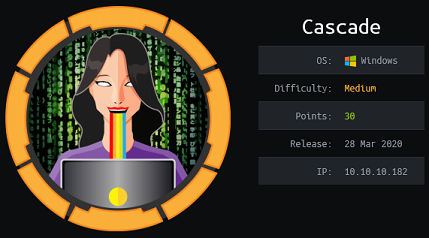 Cascade was a simple and straightforward enumeration-focused Windows box. We find the credentials for the initial account in a custom LDAP attibute then enumerate SMB shares, finding VNC credentials which can be decrypted. With those creds we find an SQlite database that contains encrypted credentials for yet another user. To decrypt the password we have to reverse a simple .NET application located on one of the shares. The final privesc involves getting the admin password from tombstone, a feature in AD that keeps deleted objects for a period of time.
Cascade was a simple and straightforward enumeration-focused Windows box. We find the credentials for the initial account in a custom LDAP attibute then enumerate SMB shares, finding VNC credentials which can be decrypted. With those creds we find an SQlite database that contains encrypted credentials for yet another user. To decrypt the password we have to reverse a simple .NET application located on one of the shares. The final privesc involves getting the admin password from tombstone, a feature in AD that keeps deleted objects for a period of time.
 During the holidays, @stackfault (sysop from the BottomlessAbyss BBS) ran a month long CTF with challenges being released every couple of days. Some of challenges were unsolved or partially solved challenges from earlier HackFest editions as well as some new ones. There was also a point depreciation system in place so challenges solved earlier gave more points. This post is a writeup for the Evilconneck challenge, a quick but fun challenge with websockets and a bit of crypto.
During the holidays, @stackfault (sysop from the BottomlessAbyss BBS) ran a month long CTF with challenges being released every couple of days. Some of challenges were unsolved or partially solved challenges from earlier HackFest editions as well as some new ones. There was also a point depreciation system in place so challenges solved earlier gave more points. This post is a writeup for the Evilconneck challenge, a quick but fun challenge with websockets and a bit of crypto.
 Buff is pretty straightforward: Use a public exploit against the Gym Management System, then get RCE. Do some port-forwarding, then use another exploit (buffer overflow against Cloudme Sync) to get Administrator access.
Buff is pretty straightforward: Use a public exploit against the Gym Management System, then get RCE. Do some port-forwarding, then use another exploit (buffer overflow against Cloudme Sync) to get Administrator access.
 Sometimes you need a break from the hard boxes that take forever to pwn. Traverxec is an easy box that start with a custom vulnerable webserver with an unauthenticated RCE that we exploit to land an initial shell. After pivoting to another user by finding his SSH private key and cracking it, we get root through the less pager invoked by journalctl running as root through sudo.
Sometimes you need a break from the hard boxes that take forever to pwn. Traverxec is an easy box that start with a custom vulnerable webserver with an unauthenticated RCE that we exploit to land an initial shell. After pivoting to another user by finding his SSH private key and cracking it, we get root through the less pager invoked by journalctl running as root through sudo.
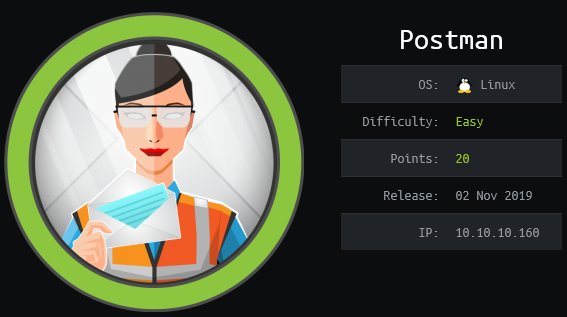 Postman was a somewhat frustrating box because we had to find the correct user directory where to write our SSH key using the unprotected Redis instance. I expected to be able to use a wordlist to scan through /home and find a valid user but on this box the redis user was configured with a valid login shell so I had to guess that and write my SSH key to /var/lib/redis/.ssh instead. The rest of the box was pretty straightforward, crack some SSH private key then pop a root shell with a Webmin CVE.
Postman was a somewhat frustrating box because we had to find the correct user directory where to write our SSH key using the unprotected Redis instance. I expected to be able to use a wordlist to scan through /home and find a valid user but on this box the redis user was configured with a valid login shell so I had to guess that and write my SSH key to /var/lib/redis/.ssh instead. The rest of the box was pretty straightforward, crack some SSH private key then pop a root shell with a Webmin CVE.
 Mango was a medium box with a NoSQSL injection in the login page that allows us to retrieve the username and password. The credentials we retrieve through the injection can be used to SSH to the box. For privilege escalation, the jjs tool has the SUID bit set so we can run scripts as root.
Mango was a medium box with a NoSQSL injection in the login page that allows us to retrieve the username and password. The credentials we retrieve through the injection can be used to SSH to the box. For privilege escalation, the jjs tool has the SUID bit set so we can run scripts as root.
 Remote is a beginner’s box running a vulnerable version of the Umbraco CMS which can be exploited after we find the credentials from an exposed share. After landing a reverse shell, we find that the machine has TeamViewer installed and we can recover the password with Metasploit then log in as Administrator.
Remote is a beginner’s box running a vulnerable version of the Umbraco CMS which can be exploited after we find the credentials from an exposed share. After landing a reverse shell, we find that the machine has TeamViewer installed and we can recover the password with Metasploit then log in as Administrator.